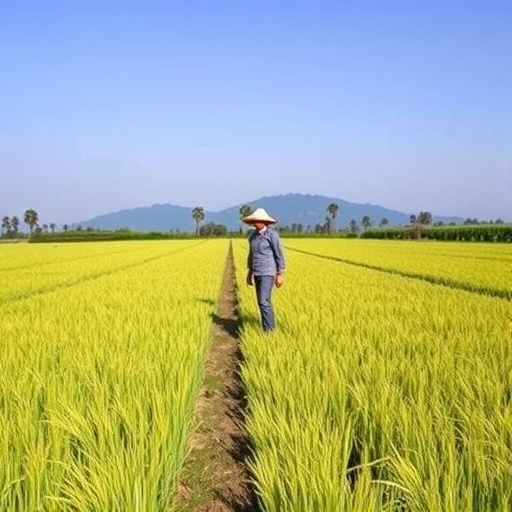In a groundbreaking advancement for sustainable agriculture, an international team of scientists has uncovered novel strategies to optimize nitrogen fertilizer use in rice cultivation across central Myanmar. This research, combining expertise from the University of Melbourne and local agricultural partners, aims at harmonizing economic gains with environmental stewardship, offering practical solutions to one of Southeast Asia’s most pressing agronomic challenges.
Rice farming in Myanmar forms the backbone of both rural livelihoods and national food security. Despite its critical role, the sector grapples with stagnant productivity and financial instability, predominantly due to reliance on entrenched traditional practices. Farmers contend with limited access to quality fertilizers, suboptimal irrigation infrastructure, and prohibitive input costs. Nitrogen, a pivotal nutrient regulating plant growth, emerges as a double-edged sword: while essential for crop vigor, its mismanagement jeopardizes soil health and surrounding ecosystems.
Quantitative agronomic trials reveal a nuanced interaction between nitrogen inputs and seasonal rice yields. During the monsoon season, characterized by high rainfall and cloud cover, incremental nitrogen supplementation produces marginal gains, constrained by limited sunlight and nutrient leaching. Conversely, irrigated dry-season rice benefits substantially from heightened solar radiation and controlled water supply, where calibrated nitrogen application nearly doubles yields from approximately 4 to 8 tons per hectare—marking a dramatic boost in production potential.
However, the indiscriminate application of nitrogen fertilizer poses multifaceted risks. Excess nitrogen disrupts rhizosphere microbial communities essential for natural nutrient cycling, culminating in soil degradation. Furthermore, nitrogen runoff into water bodies escalates eutrophication, threatening aquatic biodiversity, and contributes to greenhouse gas emissions such as nitrous oxide, exacerbating climate change. These environmental repercussions demand a precise balance between fertilizer use and ecological vulnerability.
The researchers employed integrated economic-environmental modeling to delineate “economically optimal” and “ecologically optimal” nitrogen application rates under varying seasonal contexts. Their results indicate that in the monsoon season, an application rate of approximately 83 kilograms nitrogen per hectare maximizes net economic returns at around $617 per hectare. For the irrigated dry season, this economic optimum shifts upward, with a recommended 202 kilograms nitrogen per hectare yielding benefits near $661 per hectare. Nonetheless, these figures fail to account for broader environmental externalities.
Incorporating social and ecological cost assessments transformed the fertilizer recommendations substantially. When factoring in long-term environmental degradation and pollution-associated expenses, the “ecologically optimal” nitrogen rates descend sharply to 66 kilograms per hectare for the monsoon and a mere 48 kilograms for the dry season. Although this reduction entails a marginal yield sacrifice, the avoided environmental costs, estimated at $368 per hectare per annum, represent a considerable socioeconomic gain, underscoring the value of sustainable nutrient management strategies.
Central to this research’s success was the incorporation of participatory approaches involving local farmers. Qualitative surveys and focus groups unearthed a preference for collaborative knowledge exchange through peer discussions and social media platforms rather than conventional top-down extension models. Platforms such as Facebook emerged as vital conduits for real-time dialogue, adaptation of fertilizer practices, and community-driven innovation, emphasizing the sociocultural dimensions critical for adoption at scale.
This human-centric engagement paradigm informed the development of targeted interventions, including demonstration plots that visually correlate fertilizer strategies with outcomes. Simultaneously, interactive online forums and tailored digital content disseminate localized fertilization recommendations, enhancing accessibility and responsiveness to farmer needs. Such integrative outreach mechanisms promise to accelerate the diffusion of sustainable practices across Myanmar’s diverse agricultural landscapes.
Policy uptake has responded favorably to these findings, with governmental bodies initiating the creation of digital resources and agricultural extension websites. These tools facilitate monitoring of fertilizer quality and the consolidation of agronomic data, empowering farmers and suppliers with actionable intelligence. By embedding ecological considerations within economic frameworks, these policies aspire to transform rice production systems from resource-intensive models to resilient, eco-efficient paradigms.
This research’s implications extend beyond Myanmar’s borders, serving as a reference model for analogous agroecosystems throughout Southeast Asia. The careful calibration of nitrogen inputs tailored to specific hydrological and climatological conditions provides a replicable blueprint for boosting productivity without compromising environmental integrity. It exemplifies how interdisciplinary research, paired with stakeholder engagement, can unlock pathways toward sustainable intensification in resource-limited contexts.
Underlying the study is a sophisticated array of field experiments, remote sensing data, and economic-environmental modeling tools. These technical methodologies enabled precise quantification of nitrogen-use efficiency, crop yield responses, and ecological footprints over multiple cropping cycles. The integration of social science perspectives further enriched the analysis, ensuring that proposed innovations resonate with local socio-economic realities and cultural norms.
Ultimately, this research underscores the indispensable role of optimized nitrogen management in securing food production while safeguarding environmental health. By emphasizing a multifactorial approach that balances agronomic performance, economic return, and ecological preservation, the study propels the discourse on sustainable agriculture into actionable realms. Its contributions pave the way for policy frameworks and farming practices that can foster resilience in the face of mounting climatic and economic pressures.
In the realm of scientific inquiry and agricultural development, the findings published in the inaugural volume of Nitrogen Cycling (2025) represent a milestone. They highlight the intricate interplay between nutrient management, farmer livelihoods, and ecosystem services, and affirm the necessity of interdisciplinary collaboration to address global food security challenges. The optimized nitrogen strategies articulated herein promise to empower farmers in Myanmar and beyond to cultivate rice more profitably and sustainably, heralding a new era in tropical agronomy.
Subject of Research: Not applicable
Article Title: Nitrogen use for improved profitability and sustainability of rice production in central Myanmar
News Publication Date: 11-Nov-2025
Web References: http://dx.doi.org/10.48130/nc-0025-0009
References: Liang X, Willett IR, Pandey A, Suter H, Mekala G, et al. 2025. Nitrogen use for improved profitability and sustainability of rice production in central Myanmar. Nitrogen Cycling 1: e009
Image Credits: Xia Liang, Ian R. Willett, Arjun Pandey, Helen Suter, Gayathri Mekala, So Pyay Thar, Yunrui Li, Baobao Pan, Wenyan Xie & Deli Chen
Keywords: Economics, Social sciences, Ecology, Ecosystems




